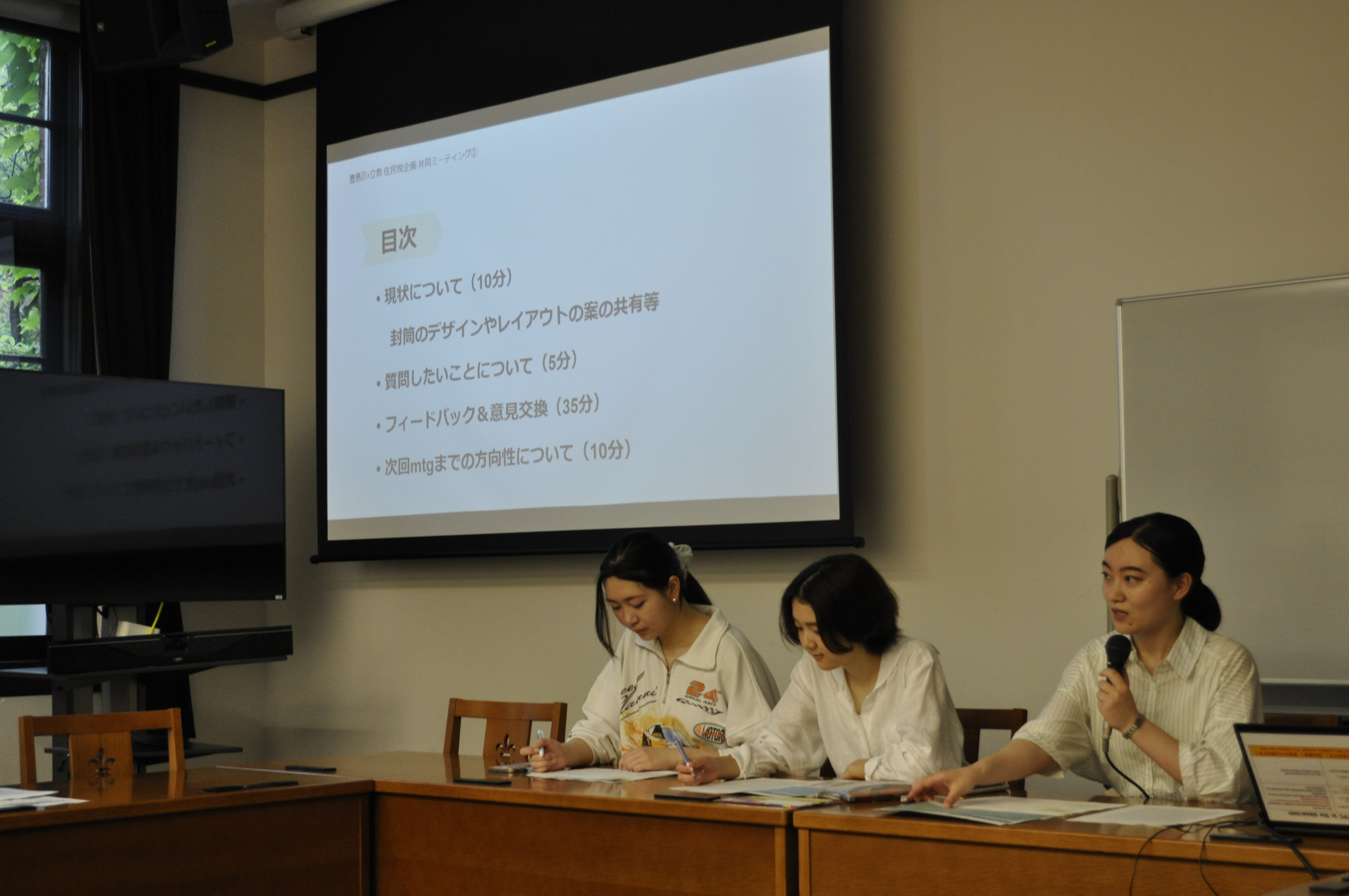Toshima City × CIC Community Collaboration Project
Contributing to the local multicultural community through the innovative ideas of students from the College of Intercultural Communication!
A collaborative project with Toshima City: “Guide to Resident Tax Payments for Foreign Residents”
Ten students from the College of Intercultural Communication, including international students from Korea, China, and Vietnam, joined forces with the Toshima City Tax Section to develop a comprehensive “Guide to Resident Tax Payments for Foreign Residents” as a vital component of the Regional Contribution Project.
Toshima City × Rikkyo University
Context of the Collaboration
In recent years, the population of foreign residents in Toshima City has experienced a remarkable surge, with over 10% of the approximately 290,000 residents originating from abroad. However, many of these residents have relocated to Toshima City from countries without a resident tax system, leading to inquiries about the need to pay resident taxes in addition to the income taxes already deducted from their part-time jobs. Recognizing the pressing need to enhance awareness of the resident tax system among foreign residents, the Toshima City Tax Section sought a solution.
As part of their efforts to combat resident tax delinquency, the Toshima City Tax Section established a tax consultation counter and included a dedicated flyer in the payment information (resident tax payment notice) for foreign residents, urging them to take advantage of the consultation service. Regrettably, the response rate, encompassing visits to the consultation counter, commitments to pay in installments, and actual payments remained disappointingly low. Consequently, the Toshima City Tax Section asked for collaboration with the College of Intercultural Communication, which, in partnership with the city, offers the “Rikkyo Japanese Language Class.” Together, they initiated a joint venture aimed at providing tailored support to foreign residents. This collaboration culminated in the creation of a comprehensive “Guide to Resident Tax Payments for Foreign Residents.”
The guide is divided into two critical components: (1) a payment notice and a corresponding envelope, and (2) a flyer encouraging foreign residents to utilize the consultation service and more. We will delve into the pivotal role played by the College of Intercultural Communication on the project, examine the project’s outcomes, and outline its contributions to multiculturalism within the community. Please join us in our reflection on this six-month endeavor aimed at creating a meaningful impact on the lives of foreign residents in Toshima City.
For more details on the Rikkyo Japanese Language Class, visit the following website.
https://icc.rikkyo.ac.jp/english/campuslife/
As part of their efforts to combat resident tax delinquency, the Toshima City Tax Section established a tax consultation counter and included a dedicated flyer in the payment information (resident tax payment notice) for foreign residents, urging them to take advantage of the consultation service. Regrettably, the response rate, encompassing visits to the consultation counter, commitments to pay in installments, and actual payments remained disappointingly low. Consequently, the Toshima City Tax Section asked for collaboration with the College of Intercultural Communication, which, in partnership with the city, offers the “Rikkyo Japanese Language Class.” Together, they initiated a joint venture aimed at providing tailored support to foreign residents. This collaboration culminated in the creation of a comprehensive “Guide to Resident Tax Payments for Foreign Residents.”
The guide is divided into two critical components: (1) a payment notice and a corresponding envelope, and (2) a flyer encouraging foreign residents to utilize the consultation service and more. We will delve into the pivotal role played by the College of Intercultural Communication on the project, examine the project’s outcomes, and outline its contributions to multiculturalism within the community. Please join us in our reflection on this six-month endeavor aimed at creating a meaningful impact on the lives of foreign residents in Toshima City.
For more details on the Rikkyo Japanese Language Class, visit the following website.
https://icc.rikkyo.ac.jp/english/campuslife/
Kick-off of the “Guide to Resident Tax Payments for Foreign Residents” Project!
■ Kick-off Meeting (February 1, 2023)
At the inaugural meeting for our collaborative effort, our primary objective was to heed the insights and requests from the Toshima City Tax Section. They provided us with an extensive overview of the resident tax situation among foreign residents, addressing the number of outstanding payments, the potential consequences of non-payment, and the specifics of the resident tax payment notice (demand letter) and its distribution process.
The Tax Section hopes to improve the response rate by focusing on young foreign residents in their twenties, as they make up 65% of the intended recipients of the notices. Additionally, they would like to plan to use simplified language to ensure clarity, provide information from an impartial standpoint, and create a new notice that incorporates the perspectives and insights of foreign students. During the meeting, some Tax Section staff expressed their anticipation for the innovative ideas that only students could provide. These suggestions encompassed the utilization of multimedia elements such as videos, illustrations, and social media.
To create a resident tax payment guide that would effectively resonate with foreign residents, it became evident that we needed to facilitate their understanding of the Japanese resident tax system. This realization prompted our decision to harness the perspectives of foreign students studying at the College of Intercultural Communication, who bring a rich array of cultural backgrounds to the table.
At the inaugural meeting for our collaborative effort, our primary objective was to heed the insights and requests from the Toshima City Tax Section. They provided us with an extensive overview of the resident tax situation among foreign residents, addressing the number of outstanding payments, the potential consequences of non-payment, and the specifics of the resident tax payment notice (demand letter) and its distribution process.
The Tax Section hopes to improve the response rate by focusing on young foreign residents in their twenties, as they make up 65% of the intended recipients of the notices. Additionally, they would like to plan to use simplified language to ensure clarity, provide information from an impartial standpoint, and create a new notice that incorporates the perspectives and insights of foreign students. During the meeting, some Tax Section staff expressed their anticipation for the innovative ideas that only students could provide. These suggestions encompassed the utilization of multimedia elements such as videos, illustrations, and social media.
To create a resident tax payment guide that would effectively resonate with foreign residents, it became evident that we needed to facilitate their understanding of the Japanese resident tax system. This realization prompted our decision to harness the perspectives of foreign students studying at the College of Intercultural Communication, who bring a rich array of cultural backgrounds to the table.
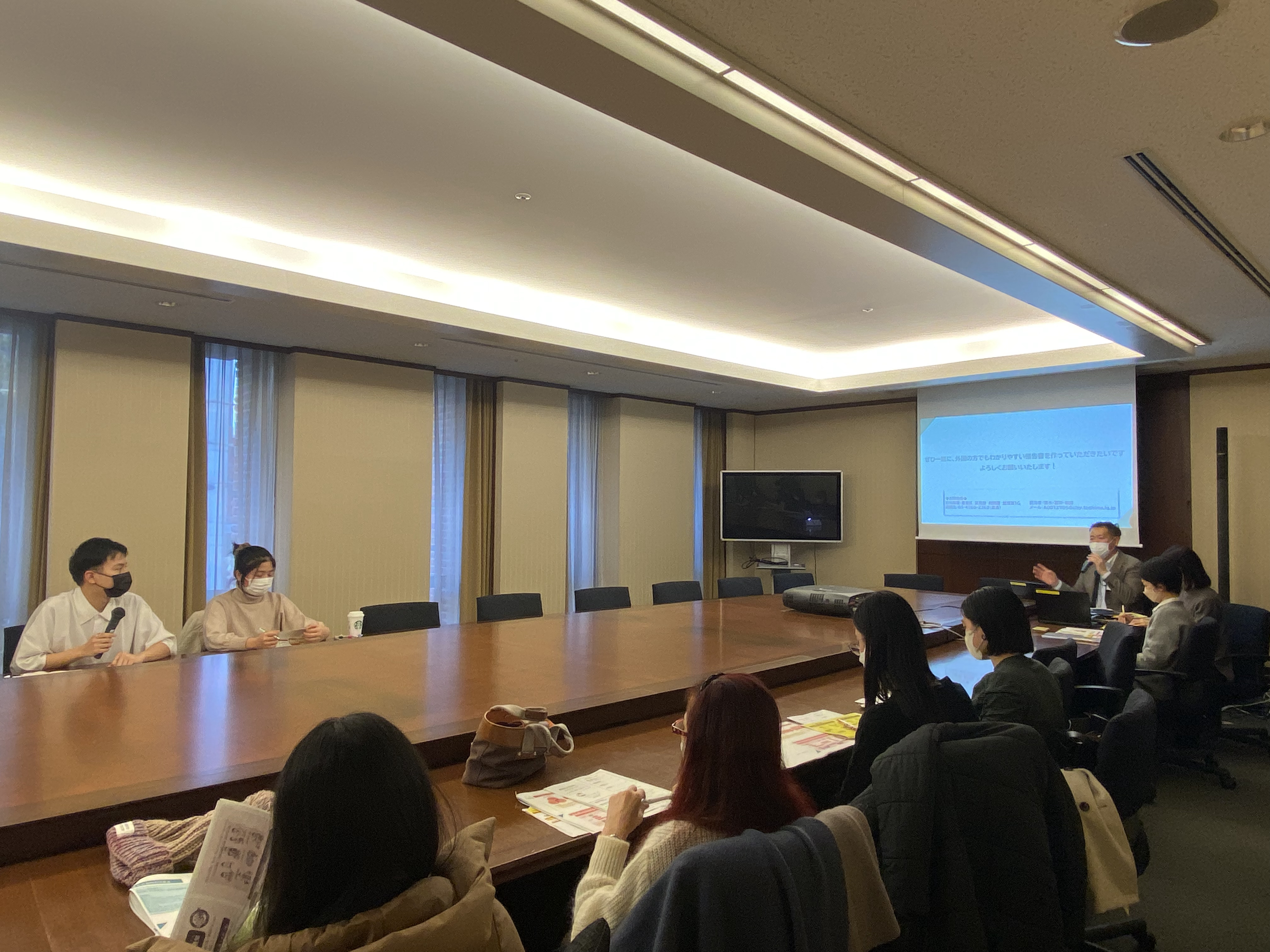
The kick-off meeting
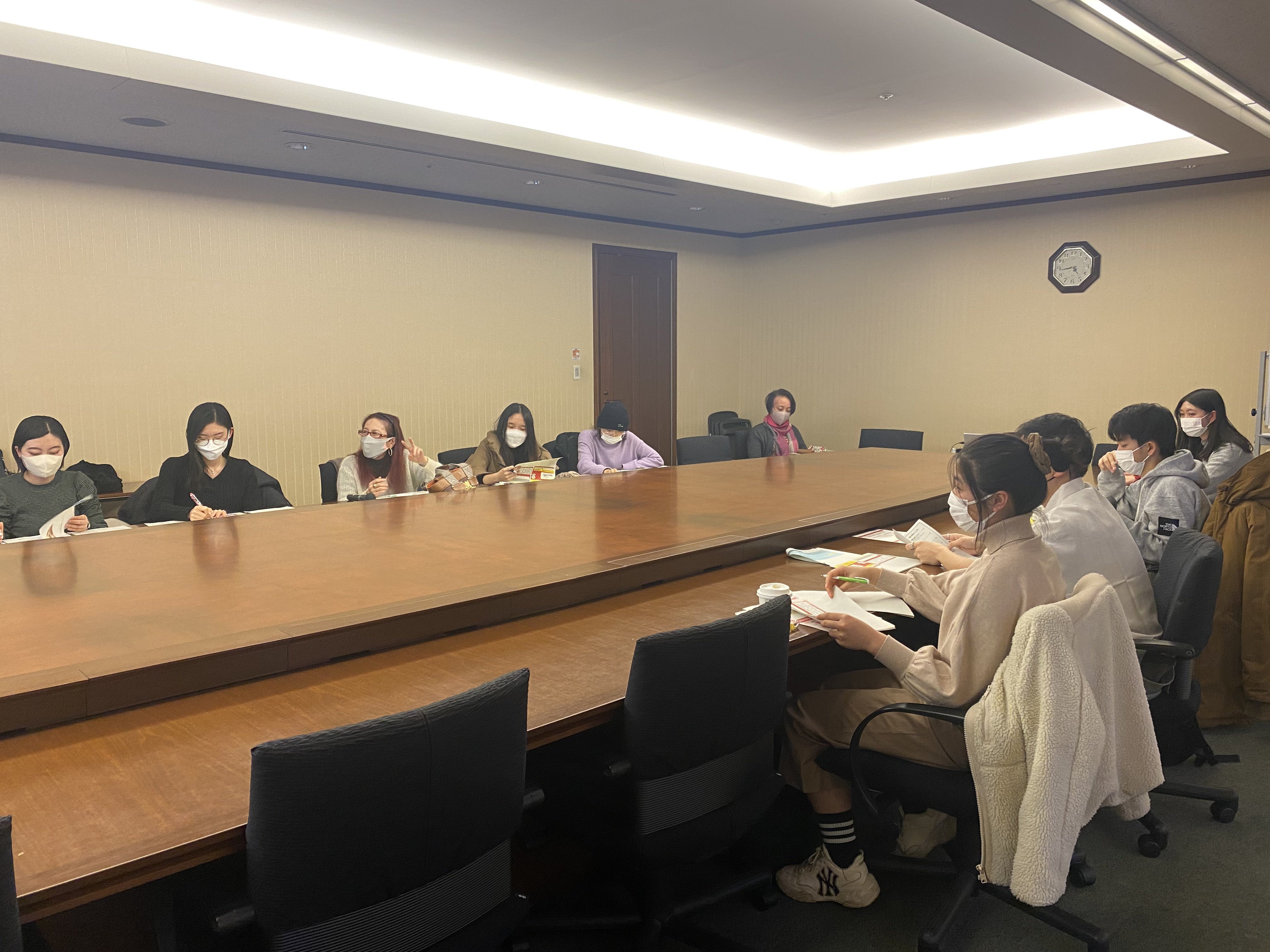
Multiple Student Meetings to Propose Measures for Increasing Response Rates among Foreign Residents
Ten students from the College of Intercultural Communication dedicated themselves to this project, conducting face-to-face meetings in classrooms, coordinating online sessions, and utilizing their free time outside of regular class hours to devise a plan for improving the response rate to payment information among foreign residents.
■ 1st Student Meeting (April 10, 2023)
Agenda: Exploring reasons for the low response rate among foreign residents
Agenda: Exploring reasons for the low response rate among foreign residents
During our initial student meeting, we delved into the underlying causes behind the low response rate among foreign residents who received the payment information and brainstormed potential solutions.
One prominent observation was that many recipients might not even open the envelopes in the first place, or they may not frequently check the contents of these envelopes. As a countermeasure, our first idea was to design an envelope and accompanying flyer with concise text and compelling visuals to entice individuals to open the envelope and engage with its contents. To address the issue of recipients being unsure about their next steps after opening the envelope, we reached a consensus to include an action flow on the flyer.
Furthermore, we considered the possibility that the content of any provided links might be too complex for some recipients. This concern was further explored in our upcoming meetings, including the question of whether including a link is necessary at all.
One prominent observation was that many recipients might not even open the envelopes in the first place, or they may not frequently check the contents of these envelopes. As a countermeasure, our first idea was to design an envelope and accompanying flyer with concise text and compelling visuals to entice individuals to open the envelope and engage with its contents. To address the issue of recipients being unsure about their next steps after opening the envelope, we reached a consensus to include an action flow on the flyer.
Furthermore, we considered the possibility that the content of any provided links might be too complex for some recipients. This concern was further explored in our upcoming meetings, including the question of whether including a link is necessary at all.

Ms. Takechi, Ms. Chao, and Ms. Ogami in an online meeting
International student Ms. Chao collected foreign residents’ opinions on payment guidance and shared them with the group.
■ 2nd - 6th Student Meetings (April 18 - May 24, 2023)
Agenda: Creating envelopes that encourage opening and flyers that capture attention
During the 2nd to 6th student meetings, following the analysis, the subsequent measures were decided.
Measure Idea #1
Eye-catching flyers
Recognizing that people often don't thoroughly examine envelope contents, we proposed redesigning the flyer to be instantly comprehensible without the need to visit a video, social networking service, or other link.
Specifically, we suggested transforming the flyer into a full-color one featuring an action flow diagram and appealing illustrations and photographs.
Measure Idea #2
“Welcoming envelopes”
Our research revealed that some recipients disregarded payment invitations, suspecting them to be scams or failing to grasp the connection to visas or income. To address this, we advocated for designing envelopes that instill a sense of security rather than utilizing bold, anxiety-inducing colors.
Other ideas involved incorporating handwritten messages on the envelopes, stylizing the Toshima City mark as a monogram, including scenic photos of the city, and featuring illustrations of facilities funded by resident tax contributions.
Through these measures, we aimed to present a payment guide that establishes Toshima City as a secure “hometown” and encourages recipients to seek further guidance from the Tax Section after understanding the utilization of resident tax funds.
Additional Ideas - Learning from the Perspective of Foreign Students
We also considered the option of distributing the flyers we created in locations frequented by the foreign community. We compiled a list of places where foreign residents commonly gather, including stores selling imported products and movie theaters, and presented this concept to Toshima City.
Japanese students found the opportunity to learn from their foreign peers invaluable. They gained insights into the foreign community, experienced the challenges associated with understanding resident tax, and found a way to acquire information that native Japanese speakers might not typically have access to.
Agenda: Creating envelopes that encourage opening and flyers that capture attention
During the 2nd to 6th student meetings, following the analysis, the subsequent measures were decided.
Measure Idea #1
Eye-catching flyers
Recognizing that people often don't thoroughly examine envelope contents, we proposed redesigning the flyer to be instantly comprehensible without the need to visit a video, social networking service, or other link.
Specifically, we suggested transforming the flyer into a full-color one featuring an action flow diagram and appealing illustrations and photographs.
Measure Idea #2
“Welcoming envelopes”
Our research revealed that some recipients disregarded payment invitations, suspecting them to be scams or failing to grasp the connection to visas or income. To address this, we advocated for designing envelopes that instill a sense of security rather than utilizing bold, anxiety-inducing colors.
Other ideas involved incorporating handwritten messages on the envelopes, stylizing the Toshima City mark as a monogram, including scenic photos of the city, and featuring illustrations of facilities funded by resident tax contributions.
Through these measures, we aimed to present a payment guide that establishes Toshima City as a secure “hometown” and encourages recipients to seek further guidance from the Tax Section after understanding the utilization of resident tax funds.
Additional Ideas - Learning from the Perspective of Foreign Students
We also considered the option of distributing the flyers we created in locations frequented by the foreign community. We compiled a list of places where foreign residents commonly gather, including stores selling imported products and movie theaters, and presented this concept to Toshima City.
Japanese students found the opportunity to learn from their foreign peers invaluable. They gained insights into the foreign community, experienced the challenges associated with understanding resident tax, and found a way to acquire information that native Japanese speakers might not typically have access to.
First Opinion Exchange Meeting with Toshima City
May 29, 2023
The eagerly anticipated opinion exchange meeting with Toshima City took place. Ms. Ogami (a senior in the College of Intercultural Communication), the project leader, presented the outcomes of the student meeting discussions. She recommended the creation of “welcoming envelopes” in soft colors with handwritten messages or illustrations to boost the open rate. Additionally, she proposed a flyer with an action flow to guide individuals who had opened the envelopes on what steps to take next.
The action flow concept was warmly received by the Tax Section staff, and it was unanimously agreed to proceed with both the envelope and the flyer as suggested by the students. Furthermore, the proposal to distribute flyers within the foreign community garnered positive feedback from the public relations staff at Toshima City.
The action flow concept was warmly received by the Tax Section staff, and it was unanimously agreed to proceed with both the envelope and the flyer as suggested by the students. Furthermore, the proposal to distribute flyers within the foreign community garnered positive feedback from the public relations staff at Toshima City.
The opinion exchange took place while reviewing the existing payment guide.
At the Presentation
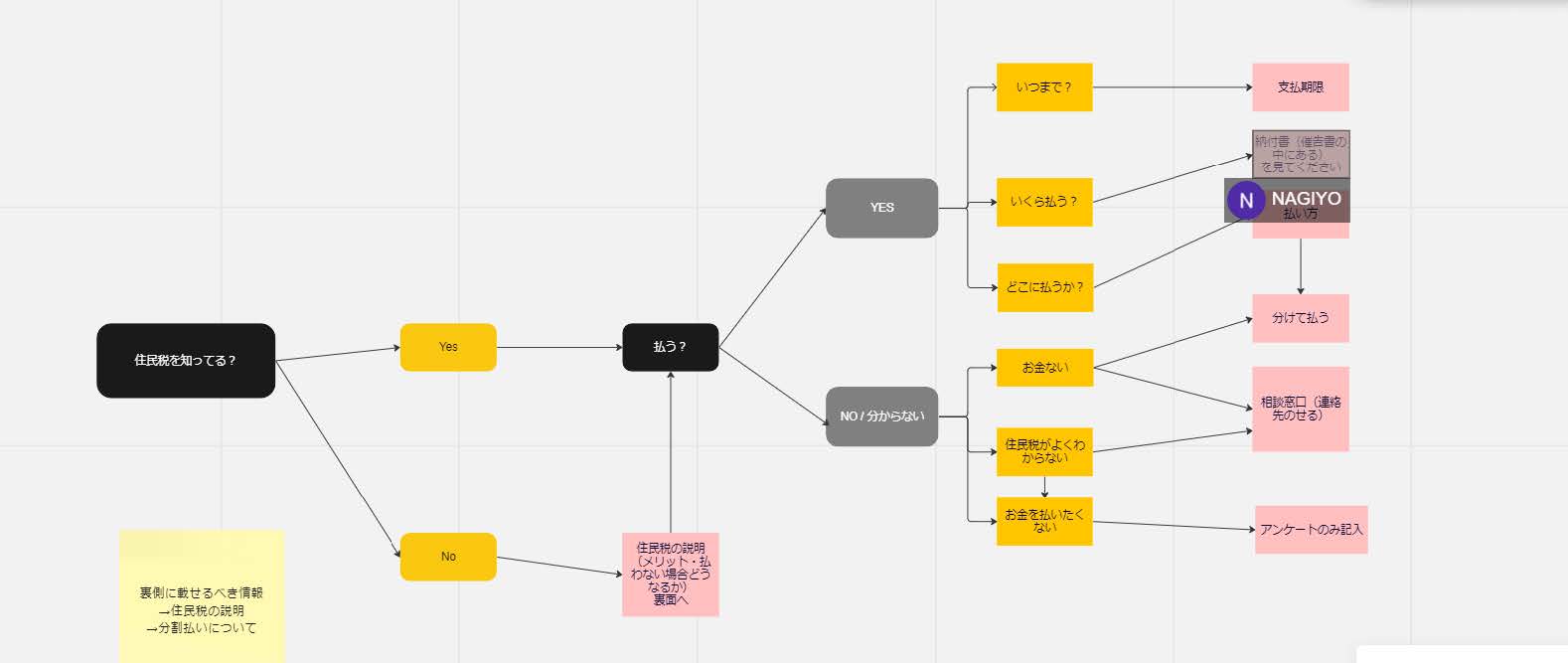
The proposed action flow diagram
Developing New Envelopes and Flyers
During the student meetings, we further refined the strategies for the upcoming (and final) meeting with the Tax Section.
■ 7th - 12th Student Meetings (June 5 - July 18, 2023)
Agenda: Developing prototypes to solidify concepts
・Envelope
We explored two envelope design options: one featuring the city’s character “Toshimananamaru” and the other without, with a direct handwritten message.
We reviewed several sample images to establish a visual direction. In order to convey a sense of friendliness, we created prototypes using various color combinations, including fluorescent colors, mixed hues, gold, silver, and more. After careful deliberation, we selected a soothing orange color as our primary choice, designed to evoke a positive and tension-free opening experience, with a fluorescent gradient as our secondary option.
・Flyer
It was determined that the flyer would transition from a two-color format to full-color printing. Furthermore, it was resolved to incorporate an action flow diagram and revise the content to ensure comprehensibility at a glance.
Building upon insights gained from the persona of a foreign resident who doesn’t pay resident tax, shared during the opinion exchange meeting with the Tax Section, we introduced the idea of including a Q&A section to enhance resident tax understanding alongside the action flow.
Addressing language barriers
In an effort to convey the messages of “we want you to read it” and “we want to support you,” we opted to rephrase the Japanese text on the envelopes in a manner more accessible to foreign residents living in Japan. Phrases like “For those who feel the payment deadline is too short” and “Let’s solve your resident tax problems together” were chosen.
As it is imperative to keep communicating that the content is crucial, we decided to include the words “Important Document” in multiple foreign languages.
Insights and ideas from the originators of the concept
When it came to the text for the flyer, we aimed to create Japanese sentences that were universally comprehensible, regardless of one’s cultural background or proficiency in the Japanese language. Typically, when we think of “easy Japanese,” we envision concise sentences using hiragana and katakana. However, Ms. Chao (a junior in the College of Intercultural Communication) from China pointed out, “Chinese individuals are more likely to grasp sentences with numerous kanji characters. The notion of ‘easy Japanese’ can vary from one country to another.” This perspective provided valuable guidance.
Ms. Ogami added, “What constitutes difficult expressions can differ among foreign students, and this realization led us to avoid treating ‘foreigners’ as a monolithic group.” She further reflected, “The knowledge I gained in the Japanese language education class at the College of Intercultural Communication and my experiences at the Rikkyo Japanese Language Class facilitated my understanding of the target audience and their language proficiency. The foreigners residing in the community were familiar to me.”
■ 7th - 12th Student Meetings (June 5 - July 18, 2023)
Agenda: Developing prototypes to solidify concepts
・Envelope
We explored two envelope design options: one featuring the city’s character “Toshimananamaru” and the other without, with a direct handwritten message.
We reviewed several sample images to establish a visual direction. In order to convey a sense of friendliness, we created prototypes using various color combinations, including fluorescent colors, mixed hues, gold, silver, and more. After careful deliberation, we selected a soothing orange color as our primary choice, designed to evoke a positive and tension-free opening experience, with a fluorescent gradient as our secondary option.
・Flyer
It was determined that the flyer would transition from a two-color format to full-color printing. Furthermore, it was resolved to incorporate an action flow diagram and revise the content to ensure comprehensibility at a glance.
Building upon insights gained from the persona of a foreign resident who doesn’t pay resident tax, shared during the opinion exchange meeting with the Tax Section, we introduced the idea of including a Q&A section to enhance resident tax understanding alongside the action flow.
Addressing language barriers
In an effort to convey the messages of “we want you to read it” and “we want to support you,” we opted to rephrase the Japanese text on the envelopes in a manner more accessible to foreign residents living in Japan. Phrases like “For those who feel the payment deadline is too short” and “Let’s solve your resident tax problems together” were chosen.
As it is imperative to keep communicating that the content is crucial, we decided to include the words “Important Document” in multiple foreign languages.
Insights and ideas from the originators of the concept
When it came to the text for the flyer, we aimed to create Japanese sentences that were universally comprehensible, regardless of one’s cultural background or proficiency in the Japanese language. Typically, when we think of “easy Japanese,” we envision concise sentences using hiragana and katakana. However, Ms. Chao (a junior in the College of Intercultural Communication) from China pointed out, “Chinese individuals are more likely to grasp sentences with numerous kanji characters. The notion of ‘easy Japanese’ can vary from one country to another.” This perspective provided valuable guidance.
Ms. Ogami added, “What constitutes difficult expressions can differ among foreign students, and this realization led us to avoid treating ‘foreigners’ as a monolithic group.” She further reflected, “The knowledge I gained in the Japanese language education class at the College of Intercultural Communication and my experiences at the Rikkyo Japanese Language Class facilitated my understanding of the target audience and their language proficiency. The foreigners residing in the community were familiar to me.”
Second Opinion Exchange Meeting with Toshima City
July 19, 2023
During the concluding meeting with Toshima City, both envelope designs and the layout of the flyer, featuring the action flow and Q&A sections, were thoroughly reviewed and finalized.
・Envelope
The selection was made for a soft orange hue that would stand out in the mail without being overly flashy or intimidating. In order to create a welcoming ambiance, an illustration of “Toshimananaru,” the city’s character, was incorporated, along with a QR code providing access to tax consultation services.
The addition of the “Important Document” label complemented the yellow color of “Toshimananaru,” mitigating any negative connotations.
⇒ Closely aligned with the initial proposal!
・Flyer
A fresh flyer was completed, featuring an action flow for the next steps and an explanatory Q&A section regarding resident tax. The transition from two-color to full-color printing was executed to capture the attention of the target audience, individuals in their 20s.
⇒ Closely aligned with the initial proposal!
・Envelope
The selection was made for a soft orange hue that would stand out in the mail without being overly flashy or intimidating. In order to create a welcoming ambiance, an illustration of “Toshimananaru,” the city’s character, was incorporated, along with a QR code providing access to tax consultation services.
The addition of the “Important Document” label complemented the yellow color of “Toshimananaru,” mitigating any negative connotations.
⇒ Closely aligned with the initial proposal!
・Flyer
A fresh flyer was completed, featuring an action flow for the next steps and an explanatory Q&A section regarding resident tax. The transition from two-color to full-color printing was executed to capture the attention of the target audience, individuals in their 20s.
⇒ Closely aligned with the initial proposal!

The second opinion exchange meeting
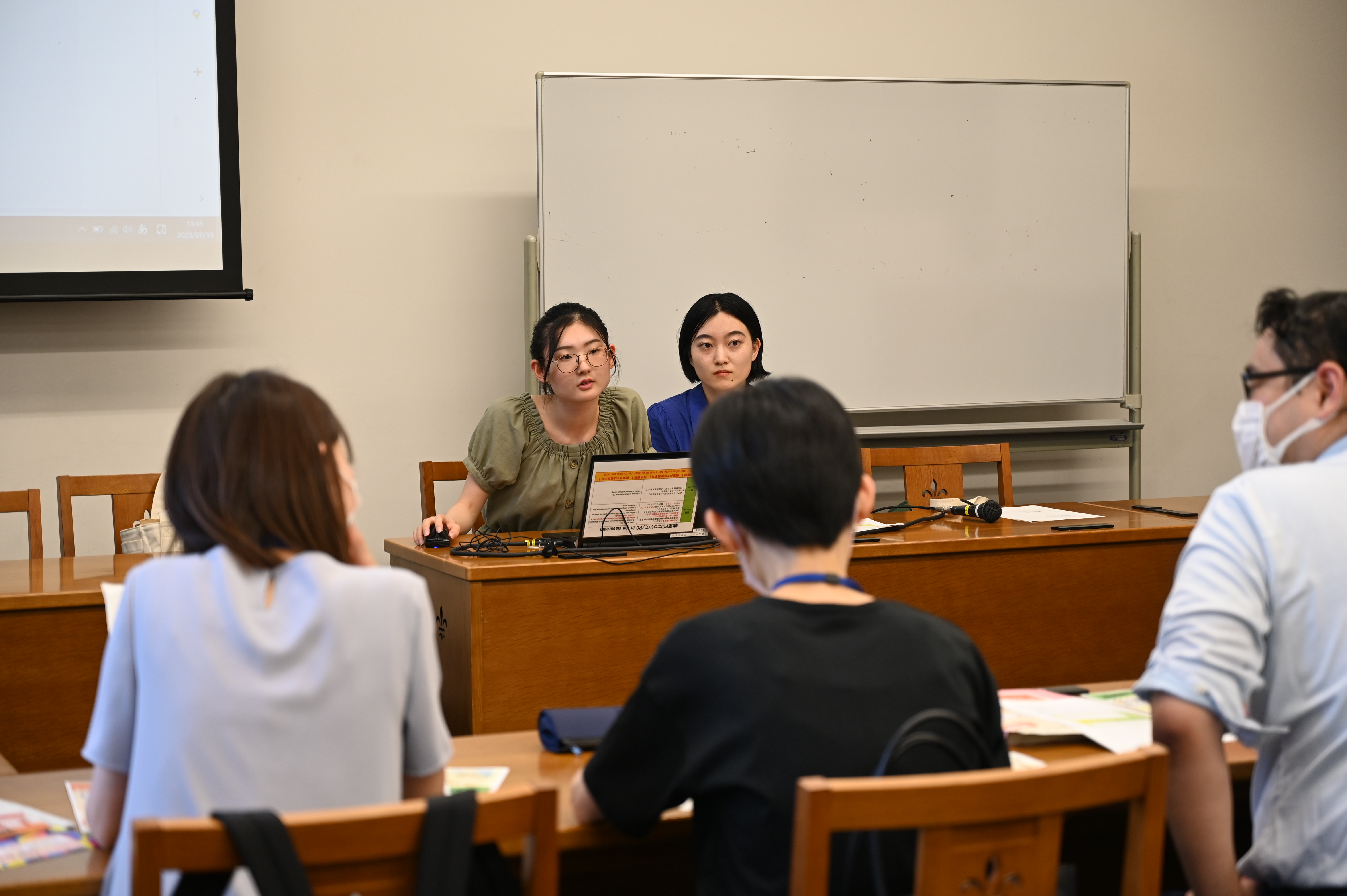
Post-Project Reflections
A discussion was held with three of the students who actively participated in the project to gather their insights after its completion.
■ Key focus aspects
・ “We proposed the utilization of softly colored envelopes that reflect Japanese aesthetics. By incorporating the action flow, we think that the flyer is now more accessible to those with limited proficiency in the Japanese language.” (Ms. Chao)
■ Challenging aspects
・ “We encountered challenges when attempting to define the specific demographic of foreigners to whom the payment information should be directed. It was a complex task to envision the intended recipients. Additionally, simplifying the language was another hurdle. Given that the explanation of resident tax often involves intricate terminology, we found it challenging to select essential information based on our initial target audience and present it in the most accessible language.” (Ms. Takechi, a senior in the College of Intercultural Communication)
■ Regarding collaboration with foreign students
・ “I found that collaborating with foreign students significantly enhanced my understanding of the perspectives and concerns of foreigners living in Japan.” (Ms. Takechi)
・ “In our meetings, there were instances where the language barrier was evident. This challenged me to explore effective ways of conveying my thoughts to everyone and engaging in discussions with individuals from diverse cultural backgrounds. I believe that these fundamental communication skills serve as the bedrock for cross-cultural understanding. Moreover, it presented a valuable opportunity to appreciate each other’s cultures while sharing ideas and expressing our own." (Ms. Chao)
■ Learning about cross-cultural understanding through the project
・ “Although I’ve had chances to interact with foreigners living in Japan (such as at the Rikkyo Japanese Language Class), my initial approach was centered on in-person interactions. Participating in this project highlighted the importance of gaining insight into the people you want to communicate with and viewing situations from their perspective, even when they are not physically present. I believe that this mindset is valuable not only for cross-cultural understanding but also for various other aspects of life.” (Ms. Ogami)
・ “I believe that this project equipped me with intercultural communication skills and a broader perspective by listening to the ideas of non-Chinese students and contemplating the issues Japanese individuals face. It fostered my desire to learn more about the intricacies of Japanese society and the challenges it currently confronts.” (Ms. Chao)
■ Our aspirations for the future
・ “I aspire to be more sensitive to the circumstances of individuals who do not fulfill their tax obligations and offer gentle support whenever possible, rather than passing judgment solely on their tax payment status. This insight emerged as I pondered the envelopes and flyers related to resident tax.” (Ms. Takechi)
・ “I believe that through our discussions, I acquired a more profound comprehension of the intricacies of Japanese societal structures. Simultaneously, I gained a fresh perspective by contrasting them with the social systems in my home country, shedding light on the shaping of culture.” (Ms. Chao)
■ Key focus aspects
・ “We proposed the utilization of softly colored envelopes that reflect Japanese aesthetics. By incorporating the action flow, we think that the flyer is now more accessible to those with limited proficiency in the Japanese language.” (Ms. Chao)
■ Challenging aspects
・ “We encountered challenges when attempting to define the specific demographic of foreigners to whom the payment information should be directed. It was a complex task to envision the intended recipients. Additionally, simplifying the language was another hurdle. Given that the explanation of resident tax often involves intricate terminology, we found it challenging to select essential information based on our initial target audience and present it in the most accessible language.” (Ms. Takechi, a senior in the College of Intercultural Communication)
■ Regarding collaboration with foreign students
・ “I found that collaborating with foreign students significantly enhanced my understanding of the perspectives and concerns of foreigners living in Japan.” (Ms. Takechi)
・ “In our meetings, there were instances where the language barrier was evident. This challenged me to explore effective ways of conveying my thoughts to everyone and engaging in discussions with individuals from diverse cultural backgrounds. I believe that these fundamental communication skills serve as the bedrock for cross-cultural understanding. Moreover, it presented a valuable opportunity to appreciate each other’s cultures while sharing ideas and expressing our own." (Ms. Chao)
■ Learning about cross-cultural understanding through the project
・ “Although I’ve had chances to interact with foreigners living in Japan (such as at the Rikkyo Japanese Language Class), my initial approach was centered on in-person interactions. Participating in this project highlighted the importance of gaining insight into the people you want to communicate with and viewing situations from their perspective, even when they are not physically present. I believe that this mindset is valuable not only for cross-cultural understanding but also for various other aspects of life.” (Ms. Ogami)
・ “I believe that this project equipped me with intercultural communication skills and a broader perspective by listening to the ideas of non-Chinese students and contemplating the issues Japanese individuals face. It fostered my desire to learn more about the intricacies of Japanese society and the challenges it currently confronts.” (Ms. Chao)
■ Our aspirations for the future
・ “I aspire to be more sensitive to the circumstances of individuals who do not fulfill their tax obligations and offer gentle support whenever possible, rather than passing judgment solely on their tax payment status. This insight emerged as I pondered the envelopes and flyers related to resident tax.” (Ms. Takechi)
・ “I believe that through our discussions, I acquired a more profound comprehension of the intricacies of Japanese societal structures. Simultaneously, I gained a fresh perspective by contrasting them with the social systems in my home country, shedding light on the shaping of culture.” (Ms. Chao)
Comments from Mr. Hirukawa, Ms. Tomita, and Ms. Sakata of Toshima City Tax Section
1. Can you explain the rationale behind involving students in this project?
Approximately one in every ten residents in Toshima City is of foreign nationality, making multicultural coexistence a pivotal policy for us. As part of our community collaboration efforts with your university, we have been conducting the “Rikkyo Japanese Language Class” for some time. In our pursuit of fostering multicultural coexistence, the city routinely provides consultations to address various daily life challenges. On this occasion, we sought forthright, impartial opinions regarding the resident tax payment issue, with a fresh perspective from students of the College of Intercultural Communication who frequently engage with foreigners.
We entrusted the students with the task of devising innovative approaches to engage foreign residents in discussions on this occasionally sensitive topic. We anticipated the kind of creative thinking that students, uniquely positioned, could offer—thinking outside the box in ways that our city staff may not be able to.
2. As this project involved collaboration with students, what were your impressions throughout the project?
Since the project commenced in January 2023, we engaged in a dynamic exchange of ideas and consistently received suggestions that exceeded our initial expectations.
Historically, the payment guides crafted by our staff primarily conveyed the message “please pay your taxes.” However, during this project, the team delved into the matter with the objective of “assisting individuals in comprehending the significance of resident tax.” As a result, the new guide was conceived to be engaging and featured adaptable concepts that were uniquely generated by students. These ideas included presenting tax-related information in the form of questions and implementing a flowchart system for clarity.
We extend our heartfelt gratitude to all the students for their dedication, even amidst their busy schedules of seminars and classes, as well as to all the teachers and staff that provided valuable guidance throughout the project.
Approximately one in every ten residents in Toshima City is of foreign nationality, making multicultural coexistence a pivotal policy for us. As part of our community collaboration efforts with your university, we have been conducting the “Rikkyo Japanese Language Class” for some time. In our pursuit of fostering multicultural coexistence, the city routinely provides consultations to address various daily life challenges. On this occasion, we sought forthright, impartial opinions regarding the resident tax payment issue, with a fresh perspective from students of the College of Intercultural Communication who frequently engage with foreigners.
We entrusted the students with the task of devising innovative approaches to engage foreign residents in discussions on this occasionally sensitive topic. We anticipated the kind of creative thinking that students, uniquely positioned, could offer—thinking outside the box in ways that our city staff may not be able to.
2. As this project involved collaboration with students, what were your impressions throughout the project?
Since the project commenced in January 2023, we engaged in a dynamic exchange of ideas and consistently received suggestions that exceeded our initial expectations.
Historically, the payment guides crafted by our staff primarily conveyed the message “please pay your taxes.” However, during this project, the team delved into the matter with the objective of “assisting individuals in comprehending the significance of resident tax.” As a result, the new guide was conceived to be engaging and featured adaptable concepts that were uniquely generated by students. These ideas included presenting tax-related information in the form of questions and implementing a flowchart system for clarity.
We extend our heartfelt gratitude to all the students for their dedication, even amidst their busy schedules of seminars and classes, as well as to all the teachers and staff that provided valuable guidance throughout the project.

Commemorative photo with the Tax Section staff
In Conclusion
Despite the diverse backgrounds and varying perspectives among students from different countries, the project leader, Ms. Ogami, expressed, “We highly regarded each individual’s sensibilities and successfully amalgamated everyone’s ideas.” The collaboration between Japanese and international students culminated in the creation of a payment guide that stands out as a unique accomplishment.
“I have a high degree of confidence in both the process and the outcomes, yet I am eager to witness the actual results. If, however, we fall short of achieving our goal (of increasing the response rate), we are committed to scrutinizing the underlying causes of our setback before contemplating the conclusion of this initiative.”
* See the following link for the report by Toshima City.
https://www.city.toshima.lg.jp/013/kuse/koho/hodo/r0509/2309261337.html (only in Japanese)
“I have a high degree of confidence in both the process and the outcomes, yet I am eager to witness the actual results. If, however, we fall short of achieving our goal (of increasing the response rate), we are committed to scrutinizing the underlying causes of our setback before contemplating the conclusion of this initiative.”
* See the following link for the report by Toshima City.
https://www.city.toshima.lg.jp/013/kuse/koho/hodo/r0509/2309261337.html (only in Japanese)
Finished Envelope and Flyer
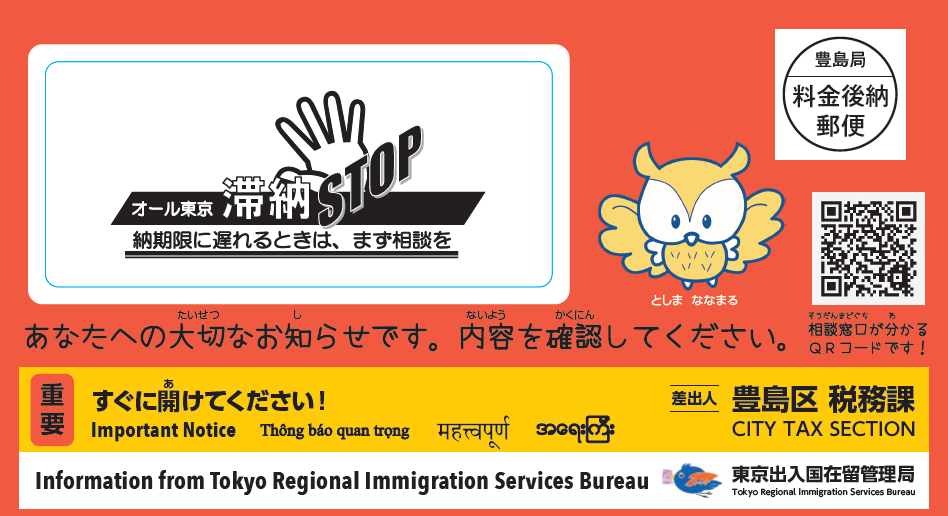
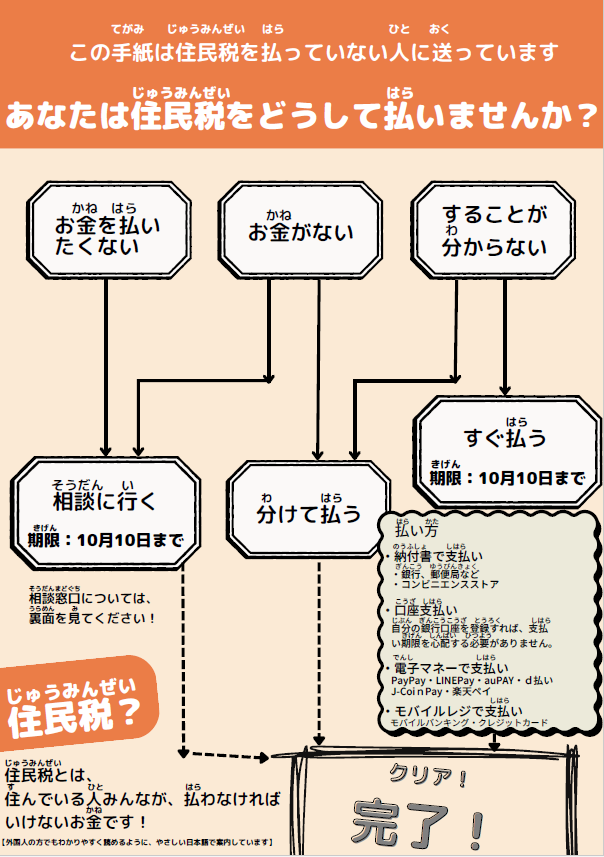
Front of Flyer
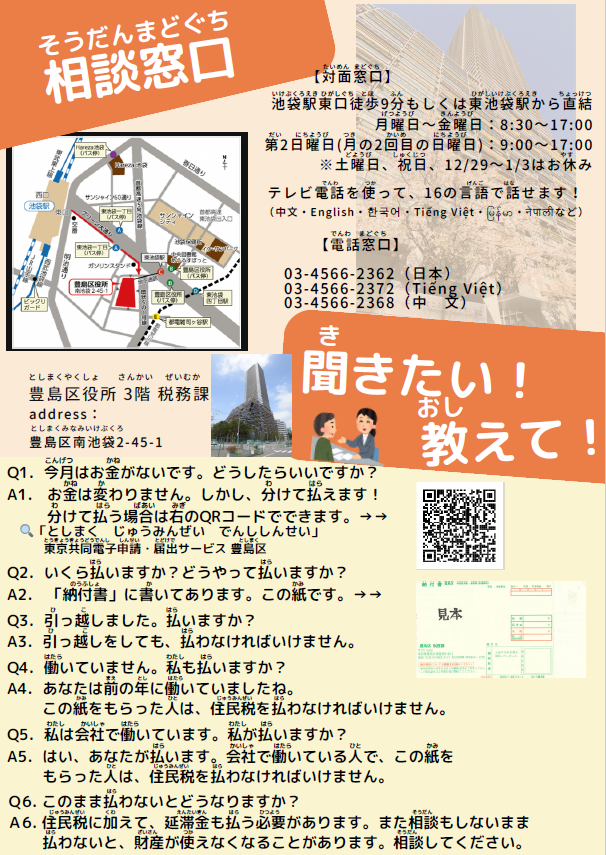
Back of Flyer


